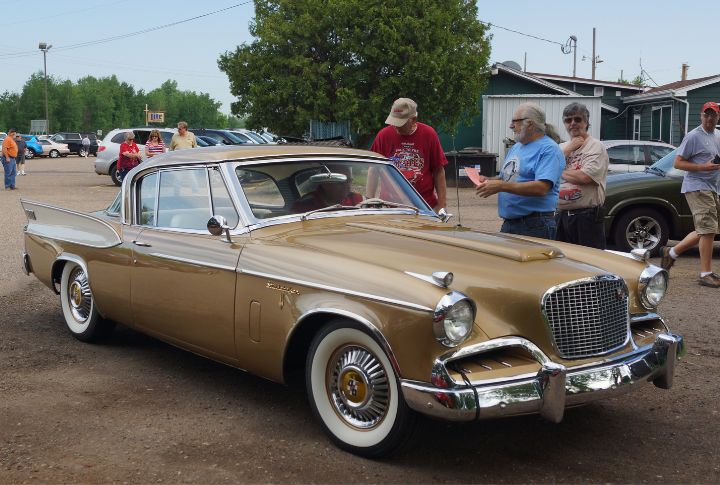
15 Vintage Cars With Cool Wings

For decades, classic cars have sported aerodynamic wings, and their stories are far more intriguing than you might think. These cool addictions sliced through the air as a testament to raw power and aerodynamic innovation. They weren’t just cosmetic additions, as wings were born from the racetrack, designed to transform a car’s handling and pin it to the pavement. Join us as we discover the world of winged classics, exploring the history, engineering, and undeniable coolness that these automotive icons brought to the road.
Chevy Bel Air – 1957

As an automotive icon, the 1957 Chevy Bel Air is instantly recognizable for its sweeping chrome fins and aggressive design. While some might scoff at these wings being purely for aesthetics, they did play a minor aerodynamic role. They helped to channel airflow, providing a modicum of stability at high speeds.
Plymouth Road Runner Superbird – 1970

Bursting onto the automotive scene in 1970, the Plymouth Road Runner Superbird’s massive rear wing, nicknamed the Air Wedge, generated significant downforce, pushing the rear tires firmly into the pavement for incredible traction during acceleration. Combined with its 426 cubic inch Hemi V8 cranking out 425 horsepower, it allowed the Superbird to achieve lightning-fast acceleration.
Cadillac Eldorado Biarritz – 1959

The 1959 Cadillac Eldorado Biarritz’s tailwinds helped decrease rear-end lift at highway speeds, contributing to a smoother ride. It was a behemoth, weighing over 5,000 pounds. The standard engine was a 345 cubic-inch V8 with 340 horsepower, enough to propel this land yacht to a respectable top speed of over 130 mph.
Dodge Daytona – 1969

To confirm the status of its race cars, automotive manufacturers needed to produce a certain number of street-legal versions inspired by NASCAR regulations. The result was the Daytona, a car that looked like it was wind-sculpted. The massive wing provided significant downforce, allowing the Daytona to hug the track at high speeds.
Ford Sierra RS Cosworth – 1982

Unlike the giant wings of the muscle car era, Cosworth’s wing integrated seamlessly into the car’s design. This rear spoiler improved stability at higher speeds produced by its 2.0L turbocharged 204 horsepower engine. The combination of power and lightweight construction made the Cosworth a legend in the world of sports sedans.
Buick Electra – 1959

Cruising alongside its Cadillac cousin, the 1959 Buick Electra embraced the wing craze with its own set of dramatic rearward appendages. While the wings on the Electra weren’t as outlandish as some, they improved stability at high speeds. Yet, their primary function remained aesthetic, reflecting the design trends of the era.
Ferrari F40 – 1987

The Ferrari F40’s wing was a true masterpiece of form and function. Crafted from lightweight composite materials, the wing generated significant downforce, pressing the car into the pavement for incredible handling during high-speed cornering. This downforce was crucial in taming the F440’s monstrous twin-turbocharged V8 engine, which unleashed a mind-blowing 478 horsepower.
Lincoln Premiere – 1957

Lincoln’s take on wings was more restrained than some, but they still offered a touch of aerodynamic benefit. Like other winged cars of the era, the Premiere’s wings helped reduce rear-end lift at high speeds, contributing to a smoother ride. They symbolized the opulence of the American luxury car market.
Pontiac GTO Judge – 1964

The 1964 Pontiac GTO Judge wasn’t quite a classic muscle car with a giant wing, but it did sport a unique aerodynamic spoiler integrated into the rear decklid. This spoiler wasn’t as dramatic as some later wings, but it did offer a slight improvement in high-speed stability.
Mercedes 190E 2.5-16 EVO I – 1990

EVO I’s rear spoiler generated significant downforce combined with its powerful Cosworth-developed 2.5L engine to produce 232 horsepower in a relatively lightweight vehicle. The EVO I was a pioneer in the world of performance sedans, proving that a well-designed wing could enhance handling without sacrificing performance.
Lamborghini Countach LP500S – 1971

As a prototype, the Lamborghini Countach LP500S gained popularity with its iconic scissor door design and massive rear wing. The wing was wind tunnel-tested and designed to generate downforce, allowing the car to reach speeds exceeding 200 mph. However, the wing affected rear visibility.
DeTomaso Pantera – 1973

This Italian muscular mid-engined sports car featured a prominent rear wing that served a dual purpose. It provided downforce for improved handling, particularly important given the Pantera’s rear-wheel-drive layout, and it added a touch of aggressive flair to the car’s design.
Lancia Thema 8.32 – 1987

In 1987, the Lancia Thema 8.32 wasn’t your average luxury sedan. It featured a Ferrari-derived 3.0L V8 engine pumping out a staggering 300 horsepower. This Italian masterpiece, built in limited numbers, featured a subtle yet functional rear spoiler. The spoiler wasn’t a giant wing but was carefully designed to generate downforce without creating excessive drag.
Porsche 911 GT2 – 1996

The rear wing of the 1996 Porsche 911 GT2 made it look like it was a Le Mans race car. It created force enough to tame the GT2’s monstrous twin-turbocharged flat-six engine, which unleashed a mind-blowing 530 horsepower. The GT2 was a force to be reckoned with on the racetrack, and its wing contributed to its performance.
Studebaker Silver Hawk – 1958

As a stylish couple, the 1958 Studebaker Silver Hawk took a unique approach to wings. They offered a minor stability benefit at high speeds but were more about style than function, reflecting the design trends of the jet age and adding a touch of futuristic flair to the car’s overall look.


